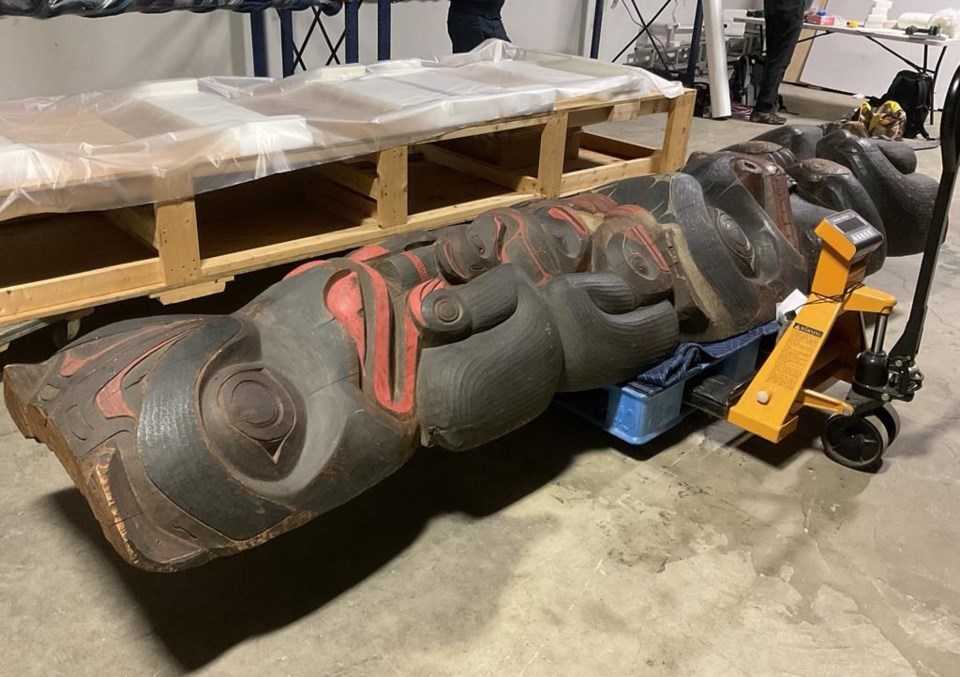VANCOUVER — In the 138 years since an Indigenous house post was chopped down and ordered burned by missionaries, it was sold under duress, damaged and displayed as a historic oddity, donated to a museum, then packed away in storage for decades.
Nowthe long-house post, which has “incredible” cultural value for the Gitxaala Nation on British Columbia’s northern coast, is on its way home.
The black and red, three-metre-tall, 180-kilogram house post has been shipped from Harvard University in Massachusetts and is expected to arrive in Prince Rupert next month.
The post depicts a grizzly bear of the sea and her cubs, which are the two main crests of the house within the nation.
Dustin Johnson, cultural program manager of the Gitxaala Nation, said the return is emotional for the nation because it connects them to their ancestors.
He said the nation hosted a meeting after word that the Peabody Museum at Harvard had agreed to return the post and some elders, including a 96-year-old member, recalled the dark history of the destruction of their culture.
"The trauma that they've seen, the sadness from seeing the great-great-grandparents being forced to cut down poles and burn them because of the Christian missionaries, the colonial government," said Johnson.
"So, this one coming back is symbolic of reclaiming our belongings, but also asserting our place back in the world. It’s like the nation standing up again as a symbol of pride, as a symbol of decolonization in bringing back something that was taken so dramatically."
The house post was one of the four posts that stood in the Grizzly Bear long house.
Johnson said Christian missionaries threatened and forced Indigenous leaders to convert to Christianity, while destroying their own cultures. The house post was sold“under duress,”he said.
“And under threat, we’re told to cut down and burn any totem poles and my ancestors refused to burn down this one because they already lost so many, and this one was saved.”
It was sold to a New England fishing company in 1885.
Jane Pickering, a director at the Peabody Museum at Harvard University, said she recognizes the"dark history" surrounding the post as it came to the United States during Canada's potlach ban in its attempt to assimilate First Nations.
The fishing company used the post as a decorative object in a “completely inappropriate” way, Pickering said.
Johnson said the post was damaged when the company inserted rods into it to project lights from it.
The house post made its way to the museum when Charles Clark Willoughby, a former director, reached out to the fishing company to negotiate its donation.
The post remained on display on the museum's first floor until 2002, when it was placed in storage.
Pickering said it wasn't until the museum was contacted by the Gitxaala Nation in 2021 to return the post that they learned of its “incredibly symbolic cultural value."
“I believe it's the only one of its type that still survives because many were destroyed,” said Pickering.
Johnson said the house post tells the stories and indicates territorial markers of the house group and extended families connected to it.
"That is our way to recognize each other just by what the crest on the house post or totem poles will look like.”
Pickering said the university began thinking about its relationships and responsibilities to Indigenous communities, both in the United States and elsewhere, and the university had published guides about the return of cultural items that are owned by Harvard.
"So, I think that was the case and this sort of cultural value was so important, so that’s why the university decided to return this."
Johnson said a big celebration would be hosted in April to celebrate the standing up of the post.
The nation said the post would be exhibited at the Museum of Northern B.C. until a museum in the village of Lax Klan is constructed.
Johnson said the house post is just one of the 73 items that the nation is trying to bring home in the next couple of years.
"And that's what we know of at the moment, but there are still many out there," said Johnson.
The nation is building a long house in the next few years and the intention is to house all of the belongings back there for educational purposes, he said.
This report by The Canadian Press was first published Feb. 2, 2023.
This story was produced with the financial assistance of the Meta and Canadian Press News Fellowship.
Nono Shen, The Canadian Press



